Introduction
Understanding the types of spots on the skin is crucial for identifying potential health issues and seeking appropriate treatment. Skin spots can vary widely in appearance, texture, and underlying cause. Recognizing these differences can empower individuals to take proactive measures in their skincare routines and health management.
These spots can appear due to a variety of factors, including sun exposure, aging, and hormonal changes. The formation of different types of spots on the skin can be influenced by genetics, environmental factors, and lifestyle choices. For instance, regions with high UV exposure, such as America and India, often see a higher prevalence of sun-induced skin spots.
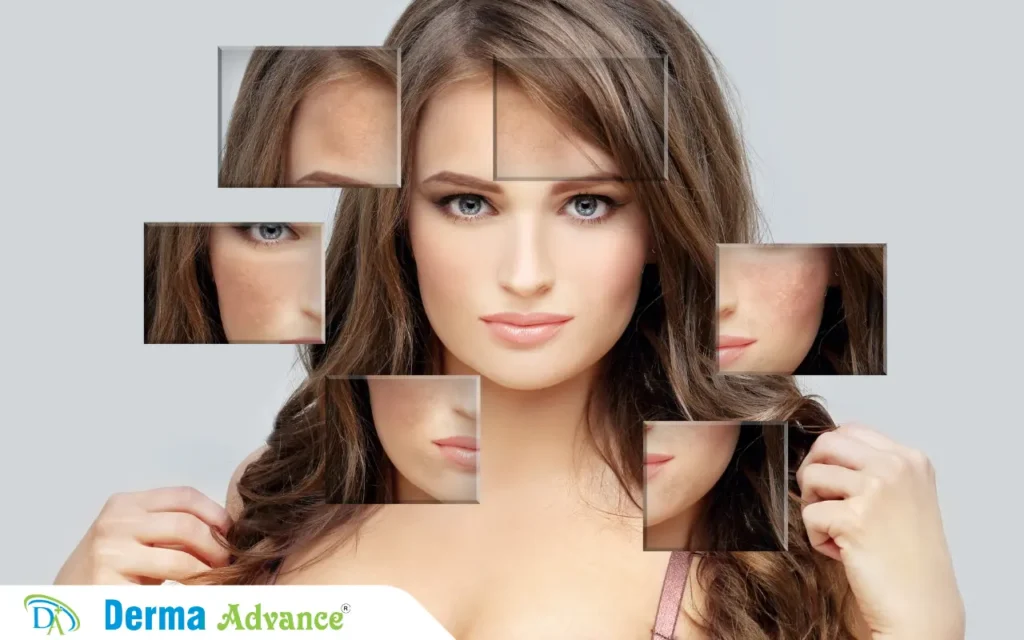
In this article, we’ll explore the most common types of spots on the skin, their causes, and how they are treated. This guide is relevant to readers across the globe, including the Middle East, as skin concerns affect people worldwide. By understanding the various types of spots on the skin, individuals can seek timely advice and appropriate treatments, ensuring healthier skin for years to come.
For further reading on the impacts of UV radiation and skin health, refer to the EPA and a comprehensive overview of common skin problems in the UAE.
To learn more about specific conditions like hyperpigmentation and melasma, explore our resources at Derma Advance.
Table of Contents
What Causes Skin Spots?
Genetics
Genetics play a significant role in how susceptible individuals are to developing various types of skin spots. For instance, certain populations, particularly in India and the Middle East, may have a higher predisposition to conditions like hyperpigmentation.
This genetic influence can lead to differences in skin tone and texture, making some individuals more prone to uneven pigmentation and other skin concerns.
Sun Exposure
One of the primary contributors to skin spots is sun exposure. Prolonged exposure to ultraviolet (UV) rays can lead to various skin issues, including sunspots and solar lentigines.
UV Damage in India and Dubai
In regions with intense sunlight, such as India and Dubai, the risk of developing sun-related skin spots is notably high. The harsh UV rays in these areas can accelerate skin aging and the formation of dark spots.
According to research from the Journal of Dermatological Science, consistent UV exposure significantly increases the likelihood of developing pigmentation issues.
Sun Exposure in America
Similarly, in the United States, particularly in sunny states like California and Florida, many individuals face the same risk. The American Academy of Dermatology highlights that sun protection is crucial for maintaining skin health and preventing unwanted spots.
Aging
Aging is another critical factor that contributes to the development of skin spots. As we age, our skin undergoes various changes, leading to conditions like age spots, which are common worldwide.
The intensity of these changes can vary significantly based on environmental factors. In regions like India and the Middle East, where sun exposure is more intense, age spots may appear earlier and with greater severity.
For insights into managing aging skin, visit our guide on melasma, which offers strategies to address pigmentation concerns effectively.
Hormonal Changes
Hormonal fluctuations can also lead to the emergence of skin spots, particularly in women. This is commonly observed during periods of significant hormonal change, such as pregnancy and menopause.
In countries like India and America, women may experience melasma, often referred to as the “pregnancy mask,” characterized by dark patches on the face. For further reading on the effects of hormonal changes on the skin, consult resources from the National Institutes of Health.
Injuries and Inflammation
Lastly, injuries and inflammation can lead to various skin spots. Conditions such as acne scars and post-inflammatory hyperpigmentation are common after skin injuries or breakouts.
This phenomenon is particularly prevalent among teenagers and young adults in regions like India and America. Understanding the causes and potential treatments for these concerns is essential, and resources like Derma Advance provide valuable insights into effective management strategies.
Common Types of Spots on Skin
Freckles (Ephelides)
Freckles are small, flat, light brown spots that often appear on sun-exposed areas of the skin, such as the face, arms, and shoulders. These spots are primarily a result of genetic predisposition, with individuals having lighter skin tones being more susceptible. Freckles occur when there is an increase in melanin production due to sun exposure, making them more pronounced during the summer months. While freckles are common in fair-skinned populations in America and Europe, they can also be found in individuals from India and Dubai, particularly among those with a lighter complexion.

Liver Spots (Solar Lentigines)
Liver spots, also known as solar lentigines, are larger, flat, brown or black patches that typically develop on sun-exposed skin areas, such as the face, hands, and arms. These spots are a direct result of prolonged sun exposure over the years and are particularly prevalent in individuals over 40. In regions like India, where intense UV rays are common, liver spots can develop earlier in life. They are often mistaken for liver-related conditions but are harmless and do not indicate any underlying health issues. However, their appearance may concern some individuals, prompting them to seek cosmetic solutions for removal or reduction.
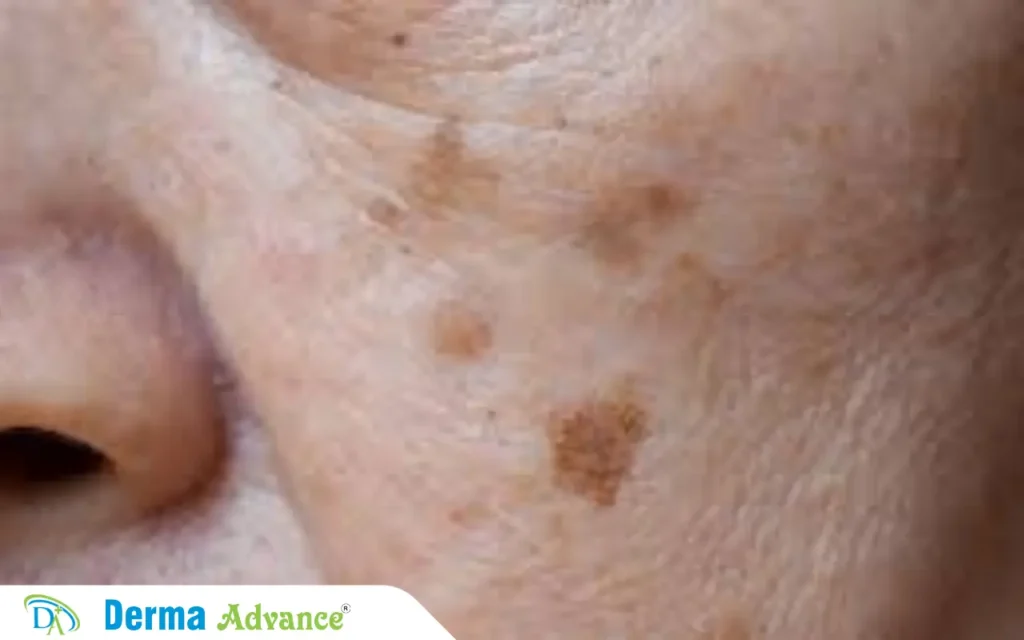
Age Spots
Age spots, often referred to as senile lentigines, typically manifest in individuals over the age of 50 and are caused by the cumulative effects of sun exposure throughout one’s life. These spots appear as flat, brown, or black marks and are commonly found on areas of the skin that receive the most sunlight, such as the face, neck, and hands. In regions with prolonged sun exposure, like India, the Middle East, and America, age spots are a common concern for many seeking to maintain a youthful appearance.
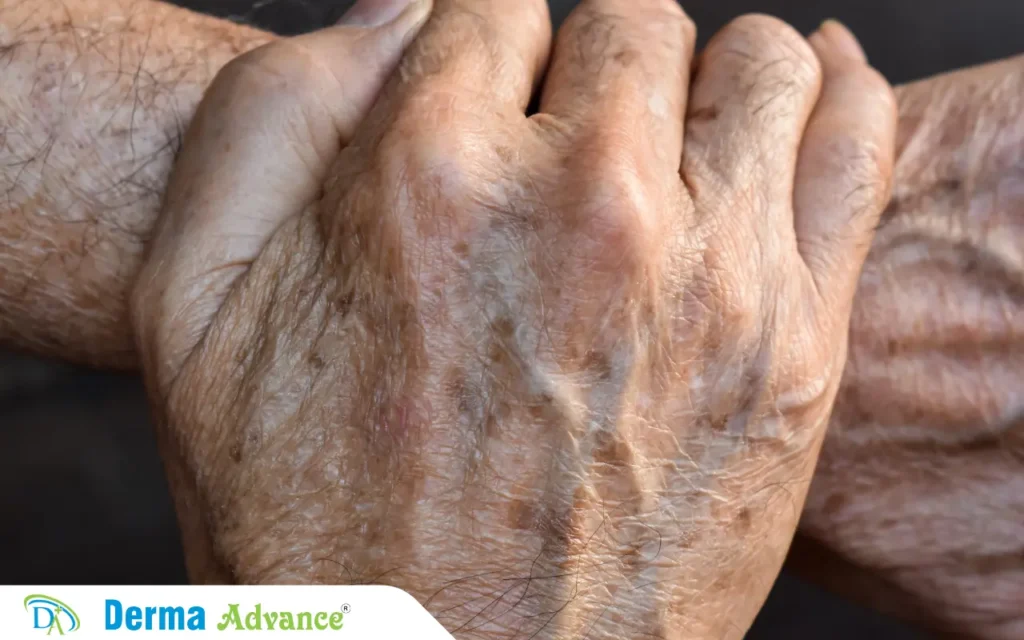
Melasma
Melasma is characterized by dark, irregular patches on the skin, commonly occurring on the face, particularly on the cheeks, forehead, and upper lip. This condition is often triggered by hormonal changes, such as those experienced during pregnancy, menopause, or with the use of birth control pills. Melasma is especially prevalent in India and the Middle East, where the combination of high sun exposure and hormonal fluctuations can exacerbate its development. Women in America also frequently experience melasma during pregnancy, often referred to as the “mask of pregnancy.” Effective treatments are available, including topical creams and laser therapies.
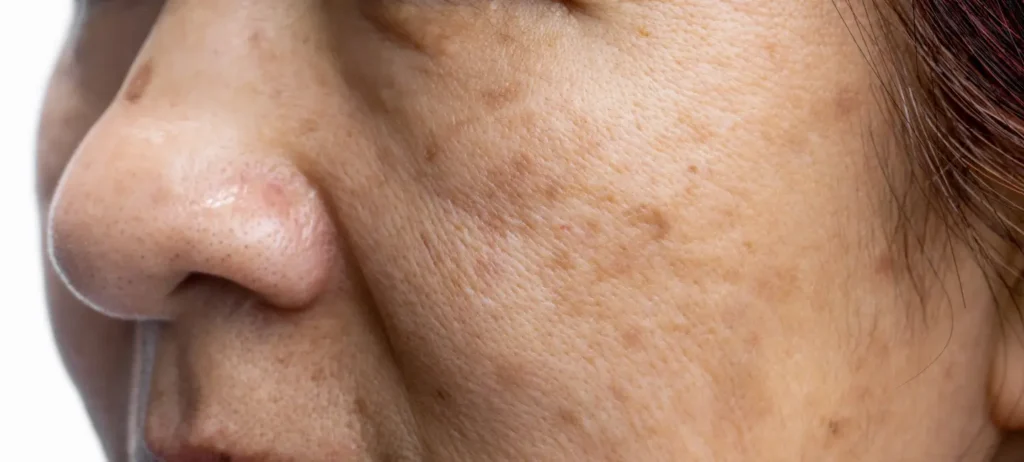
Sunspots
Sunspots, also known as solar keratosis, are flat, brown spots that develop on skin exposed to the sun. These spots are more common in sunny regions, including Dubai, California, and parts of India, where the intensity of UV radiation is high. Sunspots can appear as a result of cumulative sun damage over time. Regular application of sunscreen and protective clothing is crucial for preventing sunspots and maintaining overall skin health. If sunspots become bothersome, various treatment options are available, such as cryotherapy and laser therapy.

Spots Related to Skin Conditions
Acne Scars
Acne scars are marks left on the skin following the healing of acne lesions. These scars can manifest as dark spots (post-inflammatory hyperpigmentation), indented scars, or raised scars. They are particularly prevalent among teenagers and young adults in India and America, where acne is a common skin condition. Factors such as skin type, severity of acne, and treatment methods can influence the likelihood and appearance of scars. For more detailed insights into managing acne, visit our pages on Acne Services and Acne Scarring: Causes, Types, and Treatment.
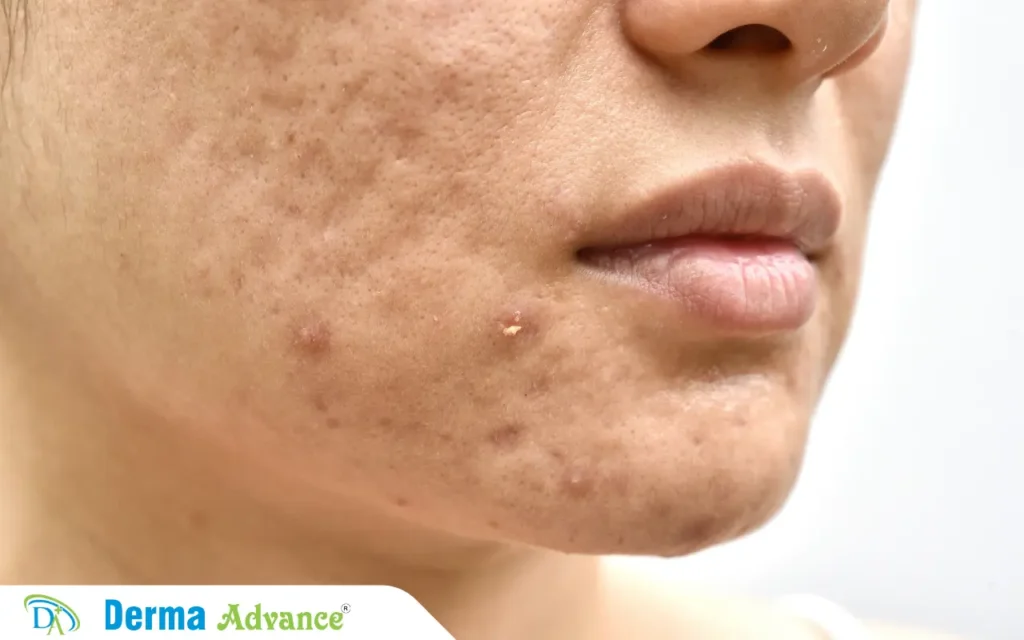
Hyperpigmentation
Hyperpigmentation refers to darkened areas of the skin caused by excess melanin production, often resulting from inflammation, injuries, or sun exposure. This condition is particularly common in individuals with darker skin tones, as seen in India and the Middle East, where melanin levels are naturally higher. Hyperpigmentation can occur following skin injuries, such as cuts or burns, and is often treated with topical agents like hydroquinone, retinoids, and chemical peels. For further information on treatments available, explore our resources on Hyperpigmentation Services and read about Treatments for Hyperpigmentation.
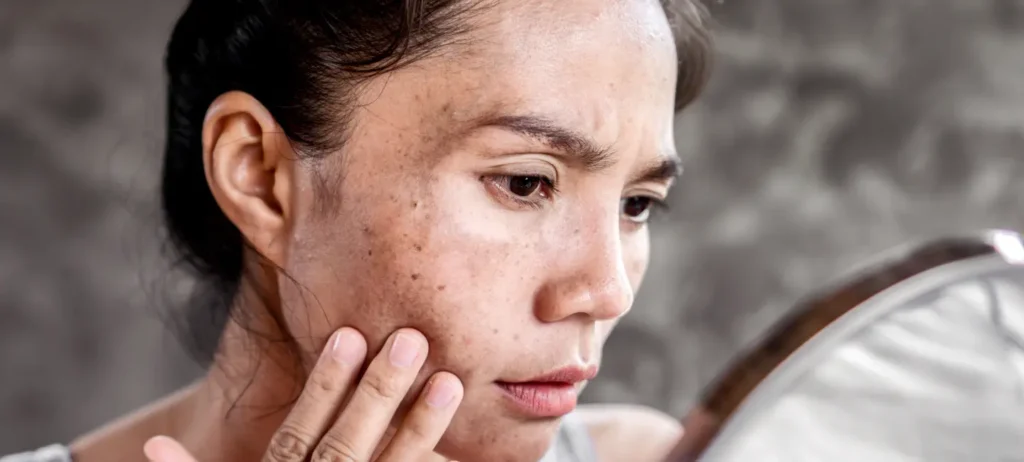
Rosacea
Rosacea is a chronic skin condition characterized by redness, visible blood vessels, and often small, red bumps on the face. While it is more prevalent among fair-skinned individuals, it can also appear in regions with hot, dry climates like Dubai and parts of India. Triggers for rosacea can include sun exposure, hot drinks, spicy foods, and emotional stress. Individuals suffering from rosacea may benefit from medical treatments, lifestyle changes, and skincare routines designed to soothe and protect the skin. For a comprehensive understanding of this condition, visit our page on Rosacea Services.

Spots That May Require Medical Attention
Moles (Nevi)
Moles, or nevi, are common skin growths that vary in size, shape, and color. They can appear anywhere on the body and are usually harmless. However, it is vital to monitor any changes in their appearance, as they can sometimes indicate skin issues, including cancer.
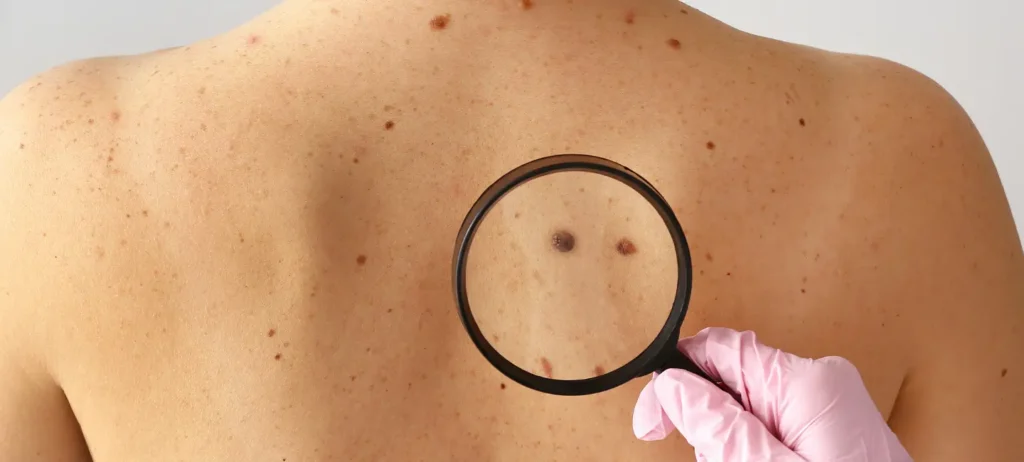
Moles and Skin Cancer in America and Dubai
In regions like America and Dubai, where skin cancer rates are high, regular dermatological check-ups are crucial. People with a significant number of moles, particularly those with atypical moles, are at a greater risk for skin cancer. The ABCDE rule is often used to assess moles:
- A – Asymmetry: One half of the mole doesn’t match the other.
- B – Border: Edges are irregular, ragged, or blurred.
- C – Color: Color is not uniform and may include shades of brown, black, or even red, white, or blue.
- D – Diameter: The mole is larger than 6mm (about the size of a pencil eraser).
- E – Evolving: The mole is changing in size, shape, or color.
Early detection is key; thus, individuals should conduct self-examinations and consult a dermatologist if they notice any concerning changes. For more information on skin checks, you can visit the American Cancer Society.
Skin Cancer (Melanoma, Basal Cell, Squamous Cell Carcinoma)
Skin cancer is a significant health concern globally, with melanoma, basal cell carcinoma (BCC), and squamous cell carcinoma (SCC) being the most prevalent types. Melanoma, while less common, is the most aggressive and can spread rapidly. In places like Dubai, America, and India, it is essential to monitor the skin for any persistent changes, such as:
- New growths or spots that appear suddenly.
- Changes in existing moles or spots, such as bleeding, itching, or crusting.
- Open sores that do not heal.
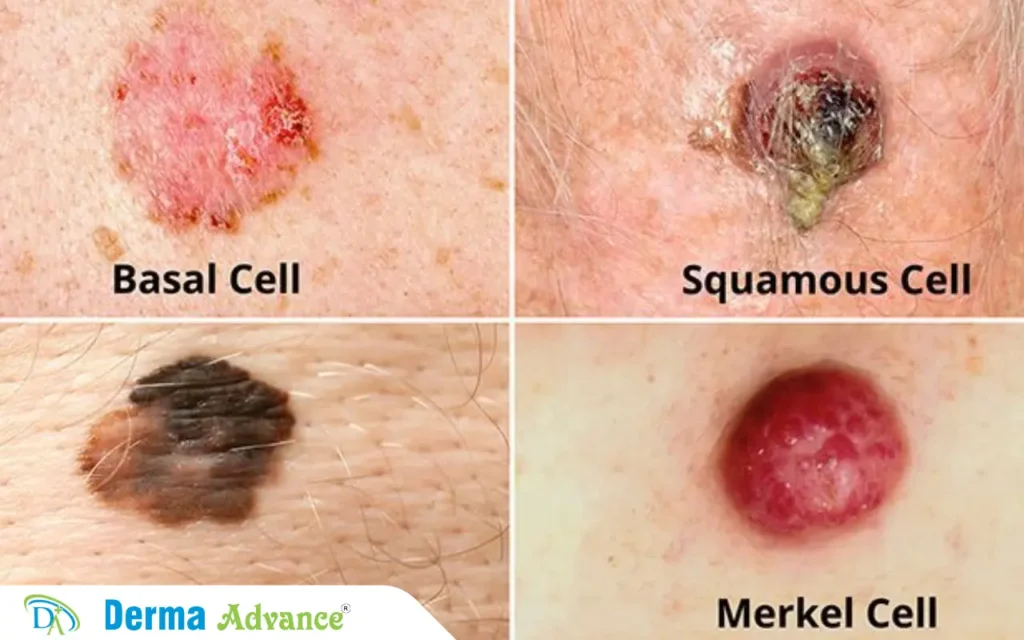
Sun protection, including the use of broad-spectrum sunscreen, protective clothing, and avoiding peak sun hours, plays a crucial role in prevention. The Skin Cancer Foundation provides extensive resources on prevention and treatment options.
Actinic Keratosis
Actinic keratosis (AK) is a rough, scaly patch that develops on skin that has been damaged by UV radiation, commonly found in regions with high sun exposure, such as America and Dubai. These spots are often tan, pink, or red and can feel dry or rough. They can be a precursor to skin cancer, making it imperative to seek medical attention. Treatments for AK include topical chemotherapy, cryotherapy, and photodynamic therapy.
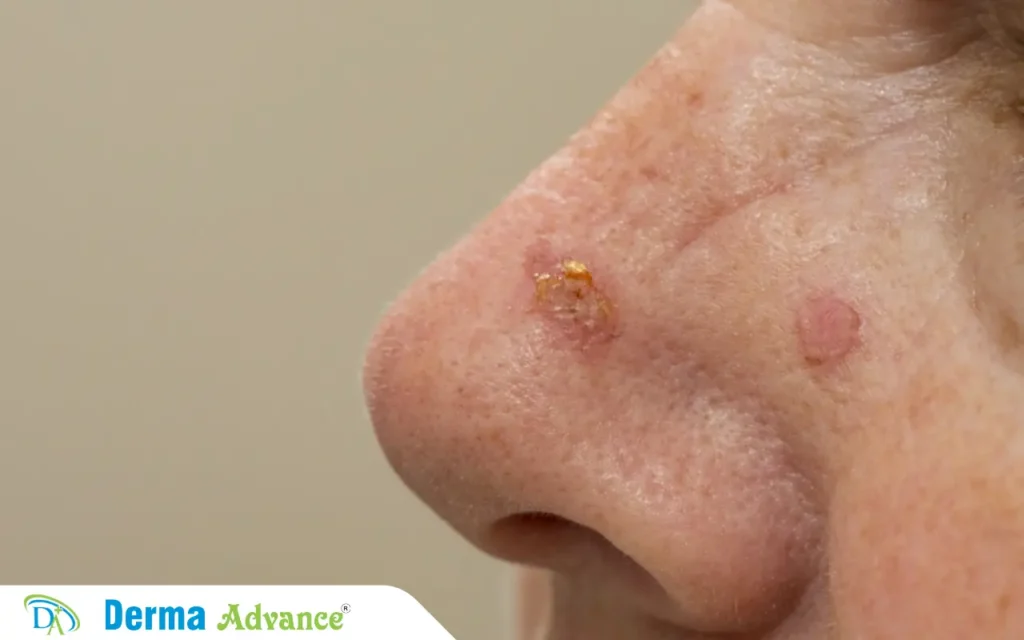
For more information about actinic keratosis and its treatment options, check out this resource from the American Academy of Dermatology.
Treatment Options for Different Types of Skin Spots
Topical Treatments
Various topical treatments are effective in managing skin spots, particularly those related to hyperpigmentation and age spots. Common options include:
- Retinoids: These vitamin A derivatives promote cell turnover and can help fade dark spots.
- Hydroquinone: A skin-lightening agent that can reduce the appearance of hyperpigmentation.
- Vitamin C Serums: These antioxidants not only brighten the skin but also protect against environmental damage.
In countries like India, America, and Dubai, these treatments are widely recommended by dermatologists and can be incorporated into daily skincare routines for optimal results.
Laser Treatments
Laser therapy has gained popularity as an effective treatment option for various skin spots, including sunspots, freckles, and melasma. This treatment uses targeted light energy to break down pigmentation and promote skin rejuvenation. Different types of lasers are employed, such as:
- Fractional lasers: These create micro-injuries in the skin, stimulating collagen production and improving skin texture.
- Pulsed dye lasers: Effective for vascular lesions and red pigmentation.
Dubai and America are at the forefront of dermatological advancements, making laser treatments a sought-after solution for many individuals seeking clearer skin.
Chemical Peels
Chemical peels involve the application of a chemical solution to exfoliate the skin’s outer layers, promoting new skin growth and reducing the appearance of scars, sun damage, and pigmentation. These peels can be categorized into three types:
- Superficial Peels: Target the outermost layer of skin, suitable for minor issues.
- Medium Peels: Penetrate deeper into the skin, effective for treating wrinkles and more pronounced pigmentation.
- Deep Peels: Reach the deeper skin layers, often requiring sedation and longer recovery.
These treatments are commonly used in India, America, and the Middle East for those looking to improve their skin’s appearance. For more information on chemical peels, visit our service page at Derma Advance.
Home Remedies for Skin Spots
Aloe Vera
Aloe vera is a popular natural remedy used in India, America, and the Middle East. It helps soothe the skin and can lighten dark spots. You can use fresh aloe vera gel by applying it directly to the dark spots. Leave it on for about 30 minutes, then rinse with lukewarm water. Regular use can improve your skin’s appearance. For more information, check out our page on How to Treat Acne at Home.
Lemon Juice
Lemon juice is known for its natural bleaching properties and is often used in home remedies in India and America. It can help lighten dark spots, but you should be careful when using it, especially in sunny places like Dubai. To use lemon juice, mix it with water and apply it to the dark spots using a cotton ball. After 10-15 minutes, rinse it off. Always apply sunscreen afterward to protect your skin from the sun. For more tips, visit Healthline.
Turmeric
Turmeric is widely used in India and the Middle East for its skin benefits. The active ingredient, curcumin, can help brighten the skin and reduce dark spots. You can make a paste with turmeric powder and milk or yogurt, then apply it to the dark spots. Leave it on for 20-30 minutes before rinsing. Remember to do a patch test first, as turmeric can stain your skin. For more on home remedies, check our page on Home Remedies for Pigmentation.
When to See a Dermatologist
Regular Skin Checks
It’s important to have regular skin check-ups, whether you’re in India, America, or Dubai. These check-ups can help catch skin problems early, including skin cancer. Dermatologists can offer personalized advice and recommend the right products for your skin. A full-body skin exam is generally recommended at least once a year, especially if you have a history of skin issues. For more insights on skin checks, refer to the American Academy of Dermatology.
Concerning Spots
Keep an eye on any new spots or changes in existing moles. This is especially important in places like America and the Middle East, where sun damage is common. You should see a dermatologist if you notice:
- Asymmetrical spots or those with irregular borders.
- New spots that appear after the age of 30.
- Changes in color, size, or shape of existing moles.
- Itching, bleeding, or crusting of any spots.
Early treatment can help prevent serious issues. If you see any concerning changes, consult a dermatologist. For more about skin cancer signs and symptoms, visit the American Cancer Society.
Prevention of Skin Spots
Sun Protection
Sun protection is a critical component of skincare, especially in sunny regions like India, Dubai, and parts of America. The sun emits harmful ultraviolet (UV) rays that can lead to skin damage, including sunspots and other forms of pigmentation.
To effectively protect your skin, it is essential to use a broad-spectrum sunscreen with a minimum SPF of 30. This type of sunscreen blocks both UVA and UVB rays, which are responsible for premature aging and skin cancer.
When applying sunscreen, make sure to cover all exposed areas, including the face, neck, ears, and any other skin that will be exposed to sunlight. It is crucial to apply sunscreen generously and reapply it every two hours. If you are swimming or sweating, reapplication should be done more frequently to maintain optimal protection.
In addition to sunscreen, wearing protective clothing can provide an extra layer of defense against harmful UV rays. Consider using long sleeves, wide-brimmed hats, and UV-blocking sunglasses to shield your skin further. For more detailed tips on effective sun protection strategies, you can refer to our guide on sunscreen.
Healthy Skincare Routine
Establishing a consistent skincare routine is vital for preventing the appearance of age spots and sunspots. This routine should include the use of quality products that cater to your skin type and concerns.
Start by incorporating antioxidants into your daily skincare regimen. Products containing vitamin C and vitamin E can help combat free radicals that cause skin damage. These antioxidants not only protect your skin from environmental stressors but also promote a brighter and more even skin tone.
Daily moisturizing is another essential step in maintaining skin hydration and health. A good moisturizer helps to keep your skin barrier intact, preventing moisture loss and maintaining elasticity. This can lead to improved overall skin texture and a reduced likelihood of developing dark spots.
Moreover, it is important to use products with SPF every day, even during winter or cloudy days. Many people underestimate the sun’s intensity during cooler months, but UV rays can penetrate clouds and still cause skin damage.
Regular exfoliation is also beneficial for maintaining healthy skin. By removing dead skin cells and promoting cell turnover, you can help prevent the buildup that can lead to dark spots. Consider using gentle exfoliants, such as those containing alpha hydroxy acids (AHAs) or beta hydroxy acids (BHAs), tailored to your skin type.
For personalized skincare tips and more information on building a skincare routine, explore our basic skincare routine page.
Conclusion
Different types of skin spots affect individuals worldwide, from India and Dubai to America. Understanding these skin spots and the importance of prevention can significantly enhance your skin health and appearance.
By practicing effective sun protection measures and maintaining a healthy skincare routine, you can reduce your risk of developing pigmentation issues. Always remember to consult a dermatologist if you notice any concerning changes to your skin, as early detection and intervention are key to better outcomes.
Prevention of Skin Spots
Sun Protection
Sun protection is a critical component of skincare, especially in sunny regions like India, Dubai, and parts of America. The sun emits harmful ultraviolet (UV) rays that can lead to skin damage, including sunspots and other forms of pigmentation.
To effectively protect your skin, it is essential to use a broad-spectrum sunscreen with a minimum SPF of 30. This type of sunscreen blocks both UVA and UVB rays, which are responsible for premature aging and skin cancer.
When applying sunscreen, make sure to cover all exposed areas, including the face, neck, ears, and any other skin that will be exposed to sunlight. It is crucial to apply sunscreen generously and reapply it every two hours. If you are swimming or sweating, reapplication should be done more frequently to maintain optimal protection.
In addition to sunscreen, wearing protective clothing can provide an extra layer of defense against harmful UV rays. Consider using long sleeves, wide-brimmed hats, and UV-blocking sunglasses to shield your skin further. For more detailed tips on effective sun protection strategies, you can refer to our guide on sunscreen.
Healthy Skincare Routine
Establishing a consistent skincare routine is vital for preventing the appearance of age spots and sunspots. This routine should include the use of quality products that cater to your skin type and concerns.
Start by incorporating antioxidants into your daily skincare regimen. Products containing vitamin C and vitamin E can help combat free radicals that cause skin damage. These antioxidants not only protect your skin from environmental stressors but also promote a brighter and more even skin tone.
Daily moisturizing is another essential step in maintaining skin hydration and health. A good moisturizer helps to keep your skin barrier intact, preventing moisture loss and maintaining elasticity. This can lead to improved overall skin texture and a reduced likelihood of developing dark spots.
Moreover, it is important to use products with SPF every day, even during winter or cloudy days. Many people underestimate the sun’s intensity during cooler months, but UV rays can penetrate clouds and still cause skin damage.
Regular exfoliation is also beneficial for maintaining healthy skin. By removing dead skin cells and promoting cell turnover, you can help prevent the buildup that can lead to dark spots. Consider using gentle exfoliants, such as those containing alpha hydroxy acids (AHAs) or beta hydroxy acids (BHAs), tailored to your skin type.
At Derma Advance, we specialize in providing personalized skincare solutions tailored to your unique skin needs. Our expert dermatologists can help you identify the best products and routines to prevent skin spots and maintain radiant skin. For personalized skincare tips and more information on building a skincare routine, explore our basic skincare routine page.
Conclusion
Different types of skin spots affect individuals worldwide, from India and Dubai to America. Understanding these skin spots and the importance of prevention can significantly enhance your skin health and appearance.
By practicing effective sun protection measures and maintaining a healthy skincare routine, you can reduce your risk of developing pigmentation issues. Always remember to consult a dermatologist if you notice any concerning changes to your skin, as early detection and intervention are key to better outcomes.
We invite you to visit Derma Advance today and take the first step towards achieving your skincare goals. Your journey to healthier skin starts with us!
Visit Us for Expert Guidance
At Derma Advance, we understand that every individual’s skin is different. That’s why we encourage you to visit our clinic for a comprehensive skin assessment. Our team of experienced dermatologists can provide tailored recommendations for your skincare regimen, ensuring you receive the best care possible.
Whether you need advice on the right sunscreen, personalized skincare products, or treatments for existing skin concerns, our specialists are here to help. We are committed to helping you achieve and maintain healthy, glowing skin.
FAQs About Skin Spots
What are the different types of skin spots?
There are many types of skin spots. Age spots, also known as liver spots, are flat brown or black marks that often appear on areas of the skin exposed to the sun as we get older. Sunspots are similar and develop due to too much sun exposure. Freckles are small, light brown spots that show up mostly on fair skin, especially in summer. Melasma causes dark, uneven patches on the face, often related to hormonal changes. Actinic keratosis is a rough patch that can develop from sun damage and may need treatment to prevent skin cancer.
What causes skin spots?
Skin spots can happen for several reasons. Sun exposure is a big one. The UV rays from the sun can lead to sunspots and age spots. Hormonal changes, especially in women during pregnancy or menopause, can lead to melasma. Genetics can play a role too; if your family has a history of skin issues, you might be more likely to develop spots. As we age, our skin changes, and this can increase the chances of spots forming.
How can I prevent skin spots?
To help prevent skin spots, start by using sunscreen every day. Choose a broad-spectrum sunscreen with at least SPF 30. Even on cloudy days, it’s important to apply it. Wearing protective clothing, like hats and long sleeves, can also help. Having a good skincare routine with products that contain antioxidants and moisturizers will keep your skin healthy. And try to stay in the shade during peak sun hours.
What home remedies can help with skin spots?
There are a few home remedies you can try. Aloe vera is great for soothing the skin and may help lighten spots with regular use. Lemon juice has natural bleaching properties, but be careful to avoid irritation, especially when you go out in the sun. Turmeric is another option; it’s known to help reduce pigmentation and improve skin tone.
When should I see a dermatologist?
It’s a good idea to see a dermatologist if you notice any new spots appearing suddenly. Changes in existing moles, like size or color, are also a reason to seek professional advice. If you have rough or scaly patches on your skin, don’t wait to get them checked.
What treatments are available for skin spots?
Depending on the type of spot, there are several treatment options. Topical treatments like creams with hydroquinone or vitamin C can help lighten spots. Chemical peels remove the top layers of skin to promote new skin growth. Laser therapy targets sunspots and age spots, helping to break down excess color. Cryotherapy uses liquid nitrogen to freeze and remove certain skin spots.
Are skin spots always a cause for concern?
Not all skin spots are serious. Many are harmless and part of natural aging. However, it’s important to keep an eye on your skin and see a dermatologist if you have any concerns. Early detection can make a big difference in skin health.
At Derma Advance, we’re here to help you with any skin concerns. Don’t hesitate to visit us for expert advice and personalized care!

